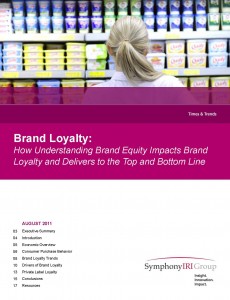timeless truths about brand loyalty
Yogi Berra once lamented that, “The future ain’t what it used to be.” Today companies have a related complaint: “Brand loyalty ain’t what it used to be.”
No longer can brands expect long-term loyalty, even from its most faithful customers. As economic pressures mount, competitive landscapes shift, and life simply happens, it may seem pointless for companies to try to lock-in customer loyalty.
Nonetheless, last month the folks at SymphonyIRI Group released a study entitled, “Brand Loyalty: How Understanding Brand Equity Impacts Brand Loyalty and Delivers to the Top and Bottom Line,” [free registration required] which attempts to deconstruct the drivers of brand loyalty.
The scope of the report is limited to consumer packaged goods, so the findings may not apply to all categories. Also the analysis defines loyalty as, “Greater than 50% of buyer’s total purchasing is of a single brand, not including ‘private label.’” While you can argue whether or not this is an accurate definition of loyalty, the report points to a few truths about brand loyalty which stand on their own and which stand the test of time.
1. Price does not equal value.
Perceived value drives loyal purchase behavior. The report explains, “…even when times are tight, brands are important. However, in the context of the new, more conservative world of CPG, brands that provide value are critical.” But value isn’t about price alone.
The researchers found that when it comes to brand decisions, 79% of consumers consider price and 76% consider past usage and trust of the brand. Shoppers also factor in requests of household members, product labels, in-store displays, and much more into their buying decisions.
Further twice as many people agree with the statement, “I tend to buy the items that give me the best value for the money” as those agreeing, “I tend to buy the lowest price item.”
So, bottom line, brands can’t bribe customers into loyalty with price.
2. As brand loyalty increases, consumers are less sensitive to price changes.
While marketers may know this intuitively, SymphonyIRI reports category data to prove the point: “In sugar and butter, where loyalty is pretty low, substantial price hikes have led to sharp drops in loyalty during the past three years. In blades and dish detergent, on the other hand, relatively high brand loyalty has continued to grow despite rather sharp price increases.”
This should be good news to the many companies whose categories have been hit with rising raw material and manufacturing costs. It suggests that consumers accept some price increases – loyalty is leverage.
And just because a category may not inspire high loyalty in general, it’s not stuck. The research shows that brands can still build loyalty during inflationary times. Chocolate candy is an example of a category with relatively low average loyalty (16%) that has seen an increase in loyalty between 2008 and 2011.
3. Private label enjoys loyalty too.
“Private label products have captured the attention, the respect, and the wallets of American consumers,” the report declares. The researchers found nearly all consumers purchase private brand products these days and more than one in three actually seek out private label products.
Although 47% of consumers are buying more private label today versus before the economic downturn began, the strength of private label isn’t simply a result of belt-tightening. Consumer perceptions of the quality of private label products have become quite favorable in some categories. Across retail channels, store brands are viewed as offering the same or better quality as national brands by more than 50% of the population.
Private label loyalty is strong and growing across many of the top 100 CPG categories, the report shows.
Concluding recommendations come straight from the report:
- Invest heavily in establishing and strengthening brand loyalty, focusing in on and delivering against the most meaningful needs of key and target shoppers.
- Leverage frequent and granular assessments of core and target shoppers to ensure a comprehensive and always-current understanding of value drivers for key categories and brands.
